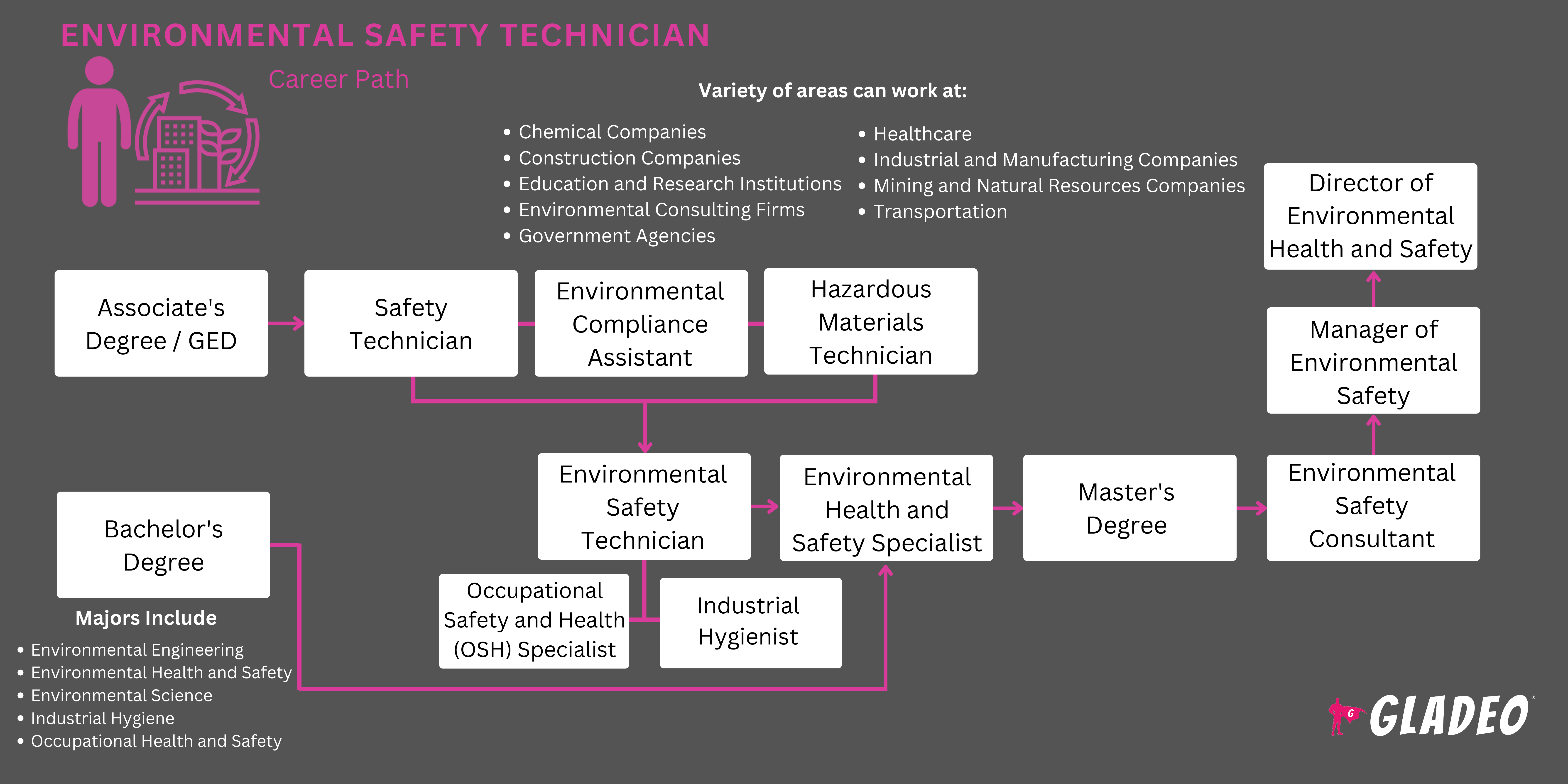Mga spotlight
Environmental Health and Safety Technician, Environmental Compliance Technician, Hazardous Materials Technician, Occupational Health and Safety Technician, Industrial Hygiene Technician, Environmental Monitoring Technician, Safety Coordinator
Some industries, like energy production, transportation, manufacturing, and agriculture, have a larger impact on the environment than others. At the same time, these industries are also among the most hazardous to work in.
Since the operations of these types of industries have the potential to harm workers and the environment, they have experts assigned to help ensure compliance with safety and environmental regulations.
Known as Environmental Safety Technicians, their job includes monitoring conditions, identifying hazards, assessing risks, and proposing solutions to mitigate risk. They also conduct inspections to make sure employers and employees follow the right procedures so that workers, communities, and ecosystems are as safe as possible.
- Implement and monitor environmental safety programs
- Contribute to pollution reduction and environmental protection
- Ensure compliance with workplace safety and health regulations and policies
- Play a key role in emergency preparedness and response
Oras ng trabaho
Environmental Safety Technicians typically work full-time. Overtime may be required for emergency response situations or to meet project deadlines. Some travel may be necessary for site evaluations.
Mga Karaniwang Tungkulin
- Monitor workplace environmental conditions; check for adherence to regulations
- Apply codes, regulations, laws, and policies related to worker health and safety
- Conduct inspections and audits to identify potential safety hazards and environmental risks. Ensure safe levels of air and water quality
- Check emission control devices for proper functioning
- Collect and analyze samples of soil, water, and gas for contaminants and pollutants, following Environmental Protection Agency guidelines
- Analyze and interpret environmental data using modeling, simulation tools, and Geographic Information Systems
- Assist in developing and implementing safety programs and emergency response plans to safeguard workers against hazardous practices and materials
- Communicate safety-related information to employees, managers, and contractors
- Provide workplace safety training; document training records, as needed
- Ensure proper use of safety equipment and personal protective equipment
- Research Safety Data Sheets, perform Toxic Substances Control Act assessments, authorize chemical use, and administer chemical tracking
- Follow guidelines in the Resource Conservation and Recovery Act
- Develop data-driven action/mitigation plans, including testing and treating Acid Mine Drainage water
- Review Stormwater Pollution Prevention Plans to ensure compliance with Occupational Safety and Health Administration (OSHA) standards
- Provide support in hazardous waste management labeling, storage, transport, and disposal
- Assist in applying for environmental and health safety permits
- Analyze incident data for trends in mishaps, injuries, and hazards
Karagdagang Pananagutan
- Calibrate test instrument
- Cooperate with external inspections
- Implement Spill Prevention, Control, and Countermeasures, as applicable
- Conduct monitoring and reporting to government agencies as required
- Maintain records related to waste characterization
- Support investigations of incidents and accidents; determine root causes and recommend preventive measures
- Prepare reports based on assessments, audits, inspections, and investigations
- Train and supervise newer technicians
- Participate in sustainability initiatives and meetings
- Research trends, best practices, and regulatory changes
Soft Skills
- Analitikal
- Pansin sa detalye
- Pakikipagtulungan
- Kritikal na pag-iisip
- Deduktibo at pasaklaw na pangangatwiran
- Mabusisi pagdating sa detalye
- Independent
- Integridad
- Pagsubaybay
- Layunin
- Organisado
- Perceptive
- Pagtugon sa suliranin
- Pag-unawa sa pagbasa
- Nakatuon sa kaligtasan
- Lakas at tibay
- Malakas na kasanayan sa komunikasyon
Teknikal na kasanayan
- Emergency response planning
- Mga lugar sa kapaligiran (hal., kalidad ng hangin, mapagkukunan ng tubig)
- Environmental monitoring, sampling, data collection, and analysis tools and techniques
- Mga regulasyon sa kapaligiran at mga hakbang sa pagsunod
- Environmental reporting tools
- Agham sa kapaligiran at ekolohiya
- Geographic Information Systems (GIS)
- Hazardous waste and materials regulations and handling procedures
- Pamamahala ng proyekto
- Pagsusulat ng ulat at presentasyon
- Safety and health assessment techniques
- Mga tool sa istatistika at pagmomodelo ng data
- Chemical companies
- Construction and infrastructure companies
- Corporate environmental departments
- Mga kumpanya sa pagkonsulta sa kapaligiran
- Government regulatory agencies (federal, state, and local)
- Mga pasilidad sa pangangalagang pangkalusugan
- Industrial and manufacturing plants
- Mining and natural resource companies
- Public and private educational institutions
- Research organizations
- Utilities (water, gas, and electric)
- Waste management and recycling companies
Environmental Safety Technicians may work in various conditions, including industrial settings or outdoors facing environmental factors. The job may require being around hazardous materials, which demands strict adherence to safety protocols.
Workers sometimes face industry resistance or public concerns, requiring them to have strong communication skills. As advocates for workplace safety and environmental stewardship, they play a crucial role in promoting and implementing effective health and safety practices and policies. At the same time, they must engage in continuous learning to stay updated on changing regulations and safety practices.
The public is putting pressure on governmental agencies to do more for the environment and to have more oversight on what organizations are doing. This push for more sustainability and accountability is resulting in new laws and updated policies and regulations at national, state, and local levels.
Environmental Safety Technicians help to explain these changes and monitor organizational compliance with them. Technology like remote sensing and advanced analytical tools is enabling them to conduct more precise monitoring and better data collection.
The incorporation of AI, wearable smart devices, robotics, and electronic reporting systems is also being used to enhance safety—but these advancements require workers to keep up with the evolving technologies.
Students who choose to become Environmental Safety Technicians often have an interest in the natural world and environmental conservation. They may have been involved in science clubs, outdoor activities, and community initiatives focused on sustainability from a young age. Their academic interests probably included subjects like biology, chemistry, and environmental studies.
- Environmental Safety Technicians typically require an associate degree, technical certification, or in some cases a bachelor’s degree
- Note, some entry-level positions may only require relevant work experience versus academic credentials
- Common degrees include:
- Associate degree in Environmental Science
- Associate degree in Occupational Health and Safety
- Bachelor’s in Environmental Engineering
- Bachelor’s in Environmental Health and Safety
- Bachelor’s in Environmental Science
- Bachelor’s in Industrial Hygiene
- Bachelor’s in Occupational Health and Safety
- Relevant coursework may include:
- Air Quality Management
- Climate Change and Global Warming
- Conservation Biology
- Ekolohiya
- Environmental Health and Toxicology
- Environmental Impact Assessment
- Environmental Law and Legislation
- Geographic Information Systems (GIS)
- Hazardous Materials Handling
- Industrial Safety
- Natural Resource Management
- Occupational Health and Safety
- Renewable Energy Sources
- Soil Science
- Waste Management
- Hands-on experience through internships, research assistant roles, or entry-level environmental health and safety jobs can be beneficial
- In addition, expect a few months of on-the-job training
- Optional industry certifications include:
- Hazardous Waste Operations and Emergency Response certification
- Certified Hazardous Materials Manager
- Occupational Hygiene and Safety Technician
- Certified Environmental Professional
- Workers may need a valid driver’s license to travel to job sites
- Environmental Safety Technicians can receive training at community colleges, universities, or even at technical or vocational schools
that offers programs or certifications in environmental safety - Look for accredited schools offering programs in environmental science, environmental health and safety, occupational health and safety, industrial hygiene, or environmental engineering
- Isipin ang iyong iskedyul at flexibility kapag nagpapasya kung mag-e-enroll sa isang on-campus, online, o hybrid na programa
- Seek programs with fieldwork and internships opportunities
- Isaalang-alang ang halaga ng matrikula, mga diskwento, at mga pagkakataon sa lokal na iskolarship (bilang karagdagan sa tulong na pederal)
- Look for programs that collaborate with external partners, which can augment your learning experience
- Suriin ang mga rate ng graduation at post-graduate na mga istatistika ng placement ng trabaho
- Ask a seasoned Environmental Safety Technician to do an informational interview with you, or see if you can shadow them at work for a day
- Watch videos and read online articles related to the career field to familiarize yourself with current environmental health and safety trends. Popular blogs include:
- Check out job descriptions posted on employment portals to determine the most current job qualifications and areas of specialization that might interest you
- In high school, load up on biology, ecology, chemistry, environmental science, math (especially algebra and geometry), physics, health science, geography, English, writing, computer science, government, and shop classes
- Engage in extracurricular activities to gain teamwork, leadership, and project management experience
- Participate in relevant online forums like the National Safety Council’s Global Health, Safety & Environment Forum
- Subaybayan ang lahat ng iyong trabaho at akademikong mga nagawa para sa iyong resume at mga aplikasyon sa kolehiyo

- Upload your resume on job portals like Indeed, SimplyHired, Monster, USAJobs, ZipRecruiter, Velvet Jobs, and Glassdoor
- Sign up for alerts so you won’t miss it when a new job is posted
- Suriin ang mga ad ng trabaho at maghanap ng mga keyword na ilista sa iyong resume, gaya ng:
- Pag-iwas sa Aksidente
- Emergency Response
- Environmental Compliance
- Environmental Management Systems
- EPA Regulations
- Hazardous Materials Management
- Health and Safety Programs
- Incident Investigation
- Industrial Hygiene
- OSHA Standards
- Policy Development
- Risk Assessment
- Safety Audits
- Safety Regulations
- Safety Training
- Workplace Safety
- Review Environmental Safety Technician resume templates and sample interview questions
- Ask your school to connect you with recruiters. Take advantage of chances to intern with environmental safety-related organizations
- Reach out to your school’s career center to get resume help, do mock interviews, and learn about upcoming job fairs
- Do your research on potential large employers, such as:
- Mga Sentro para sa Pagkontrol at Pag-iwas sa Sakit
- Department of Defense
- Kagawaran ng Enerhiya
- Ahensya sa Pangangalaga sa Kapaligiran
- Federal Emergency Management Agency
- National Aeronautics and Space Administration
- National Institutes of Health
- Pangangasiwa sa Kaligtasan at Kalusugan sa Trabaho
- United States Department of Agriculture
- United States Geological Survey
- Sa panahon ng mga panayam, ipakita ang isang matalas na kamalayan sa mga uso sa industriya
- Magsuot ng propesyonal para sa mga panayam sa trabaho
- Hilingin sa mga nakaraang propesor at superbisor na magsulat ng mga liham ng rekomendasyon o humiling ng kanilang pahintulot (in advance) na ilista ang mga ito bilang mga sanggunian
- Speak with your supervisor about advancement. Get advice and talk through options
- Show your willingness to learn, follow procedures, and assume increased responsibilities
- Set the bar high and ensure compliance with regulations to help protect workers, equipment, facilities, work sites, and surrounding areas
- Manatiling aktibo tungkol sa propesyonal na pag-unlad at pagkuha ng patuloy na mga kurso sa edukasyon
- Knock out additional certifications when qualified to do so, like the Board of Certified Safety Professionals - Associate Safety Professional
- If beneficial, consider doing a higher-level college degree
- Try to gain diverse experience across different workplace environments. After working in different areas, consider specializing in a particular area such as:
- Accident Investigation
- Air Quality Management
- Biological Safety
- Chemical Safety
- Construction Safety
- Emergency Response Planning
- Environmental Compliance
- Ergonomya
- Fire Safety and Prevention
- Hazardous Waste Management
- Industrial Hygiene
- Noise Control and Hearing Conservation
- Occupational Health
- Radiation Safety
- Regulatory Compliance and Auditing
- Risk Assessment and Management
- Safety Engineering
- Sustainability and Environmental Protection
- Water Quality Management
- Workplace Safety Training
- Be active in professional organizations such as the American Industrial Hygiene Association (see our list of Recommended Resources for more information)
- Keep current on changes related to employer policies and local, state, or federal regulations
Mga website
- Academy of Board Certified Environmental Professionals
- Accreditation Board para sa Engineering at Teknolohiya
- Samahan ng Pamamahala ng Hangin at Basura
- American Academy of Environmental Engineers and Scientists
- American Chemical Society
- American Conference of Governmental Industrial Hygienists
- American Industrial Hygiene Association
- American Mosquito Control Association
- American National Standards Institute
- American Public Health Association
- American Society for Microbiology
- American Society of Safety Professionals
- ASTM International
- Board para sa Global EHS Credentialing
- Lupon ng Sertipikasyon sa Propesyonal na Ergonomya
- Board of Certified Safety Professionals
- Mga Sentro para sa Pagkontrol at Pag-iwas sa Sakit
- Konseho ng Industrial Engineering
- Department of Defense
- Kagawaran ng Enerhiya
- ENERGY STAR
- Ahensya sa Pangangalaga sa Kapaligiran
- Federal Emergency Management Agency
- Health Physics Society
- Institute of Hazardous Materials Management
- Institusyon ng Engineering at Teknolohiya
- International Society for Sustainability Professionals
- International Society of Automation
- International Society of Exposure Analysis
- Pamumuno sa Enerhiya at Disenyong Pangkapaligiran (LEED)
- National Aeronautics and Space Administration
- National Association for Environmental Management
- National Association of Environmental Professionals
- National Association of Safety Professionals
- National Board of Public Health Examiners
- National Council of Examiners for Engineering and Surveying
- National Environmental Health Association
- National Fire Protection Association
- National Institute for Certification in Engineering Technologies
- National Institute for Occupational Safety and Health
- National Institutes of Health
- National Recreation and Park Association
- National Registry of Environmental Professionals
- National Safety Council
- NSF International
- Pangangasiwa sa Kaligtasan at Kalusugan sa Trabaho
- Regulatory Affairs Professionals Society
- Society for Mining, Metallurgy and Exploration
- US Green Building Council
- United States Department of Agriculture
- United States Geological Survey
- World Safety Organization
Mga libro
- Safety Risk Management: Preventing Injuries, Illnesses, and Environmental Damage, by Fred Fanning
- Safety WALK Safety TALK: How small changes in what you THINK, SAY, and DO shape your safety culture, by David Allan Galloway
- The Beginner’s Guide to the Environmental, Health and Safety Profession, by Chance Roberts
Environmental Safety Technicians play a crucial role in protecting our workers, communities, and natural environment. But this career isn’t the right fit, consider related fields that might interest you, such as:
- Brownfield Redevelopment Specialist
- Conservation Scientist
- Inspektor ng Konstruksyon at Gusali
- Environmental Compliance Inspector
- Environmental Engineering Technologist
- Siyentipiko sa Kapaligiran
- Inspektor ng Sunog
- Geological Technicians
- Technician ng Mapanganib na Basura
- Inhinyero sa Kalusugan at Kaligtasan
- Hydrologist
- Industrial Hygienist
- Siyentista sa Materyales
- Microbiologist
- Pagmimina at Geological Engineer
- Espesyalista sa Kalusugan at Kaligtasan sa Trabaho
- Public Health Officer
- Tagapamahala ng seguridad ng
- Water/Wastewater Engineer
- Espesyalista sa Yamang Tubig
- Wildlife Biologist
Newsfeed

Mga Tampok na Trabaho

Mga Online na Kurso at Tool








